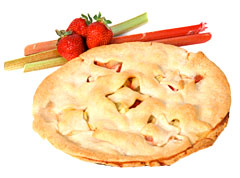
Gaia has been hard on us prairie-dwellers lately. A dear friend who’s the director of the area’s largest CSA lost her 102-year-old barn to a storm this weekend. Swelled with recent rains, the Iowa River has been raging, sloshing toward levels never seen before.
Fortunately, my restaurant sits on high ground, so if the floods reach us here, you’ll see the animals lining up two by two and Kevin Costner frowning from the roof. We’re lucky, too, that many of the local farms that supply us are also keeping their heads above water, and bringing us loads of those sure signs that it’s June: strawberries and rhubarb.
Known for its puckeringly sour stalks, rhubarb is a humble plant that’s not often toyed with in “gourmet” kitchens. Historically, it was a medicinal herb, grown mainly in monastery gardens “to stock abbey pharmacies with its medicinal roots,” food historian Waverley Root tells us. Its status as food came later, in England. Rather than focus on the stalks, early rhubarb lovers actually ate the leaves as some would spinach. The flavor must have been enjoyed by survivors, since the leaves contain oxalic acid and have, according to the Oxford Book of Food Plants, “sometimes caused death.”
Today, we stick to the stalks.
In our restaurant garden, the rhubarb is only two years old, and it’s best to wait until its third birthday before harvesting it. Like asparagus, it’s a perennial that needs time to develop a strong root system and thick stalks.

The real deal.
Photo: Kurt Michael Friese
Strawberries have been known and prized all over the world for centuries. Until relatively recently, they were rare treats, since they only grew wild and were extremely perishable. Today, farmers have learned to cultivate them on an industrial scale. But those golf ball-sized wonders bear little resemblance to the real thing on the palate. They’ve been hybridized beyond recognition in an effort to maximize shelf life and portability. Flavor and nutritional value have not been concerns among their growers or purveyors.
At my restaurant, we use the perishable heirloom varieties that actually taste like something. Since they need to be harvested and consumed quickly, you won’t see strawberries on our menu in January. So when their time does come, we revel in them eagerly.
Strawberries draw considerably more enthusiasm among eaters than rhubarb, but almost no one disapproves of the two in combination. Few dishes are as down-home-prairie as a strawberry-rhubarb pie. The sweet berries and sour stalks offer contrasting flavors, but both emerge from the garden at the same time. And in pie, they combine for a kind of harmony.

Tao of pie.
Strawberry-Rhubarb Pie
Here is a very simple recipe for a filling to use in your favorite crust.
1/4 cup flour
1/4 teaspoon salt
3 cups fresh rhubarb — peel with a vegetable peeler and chop
3 cups fresh strawberries — clean and slice in half
1 plain (homemade or store-bought) pie crust — enough for bottom and top crust
Preheat oven to 425 degrees F.
Sift together all dry ingredients. Sprinkle bottom of crust with 1/3 of dry mixture. Gently add rhubarb and strawberries and heap onto pie shell. Create a slight mound in center. Sprinkle remaining mixture over rhubarb and strawberries. Dot with butter; cover with top crust, arranging the pastry in a lattice pattern, or leave whole with decorative cuts to vent.
Bake 10 minutes at 425 degrees F; reduce to 350 degrees F, and bake 40 to 50 minutes. Allow to cool on a wire rack before cutting.


